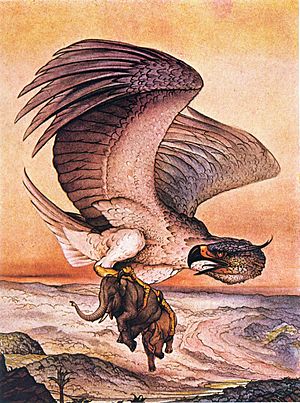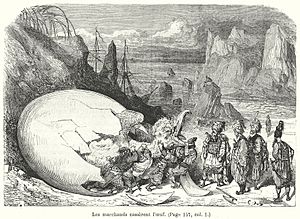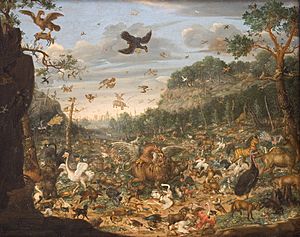Roc (mythology) facts for kids
|
Roc by Edward Julius Detmold
|
|
| Grouping | Mythology |
|---|---|
| Similar creatures | Garuda, simurgh, phoenix, thunderbird |
| Mythology | Middle Eastern |
| Other name(s) | Rukh |
| Habitat | Air |
The roc (also called rukh or rux) is a giant, legendary bird of prey from the Middle East. Imagine an eagle, but much, much bigger!
Stories about the roc are found in old Arabic books about geography and nature. It became very famous in Arabian fairy tales and in stories told by sailors. For example, the famous traveler Ibn Battuta wrote about a mountain that seemed to float in the air over the China Seas, which he believed was the roc. The well-known collection of stories, One Thousand and One Nights, also features the roc in tales like those of Sinbad the Sailor.
Contents
What's in a Name?
The name "roc" comes from the Arabic word ruḵḵ. This word itself came from the Persian word ruḵ. In both languages, Arabic and Persian, the word is written the same way.
Where Did the Roc Story Begin?

Experts believe the idea of the roc might have started from ancient Indian stories. These tales tell of a powerful sun bird named Garuda. Garuda was often shown fighting a snake-like creature called a Nāga.
One famous story about Garuda is found in two old Sanskrit poems, the Mahabharata and the Ramayana. In this story, Garuda carries away a huge elephant that was fighting a crocodile. This image of a giant bird carrying a large animal might have inspired the roc legend.
The Roc in Western Tales
In the 13th century, the famous explorer Marco Polo shared his own version of the roc story. He described it as an enormous eagle. He said its feathers were about twelve paces long! Marco Polo claimed the roc was so strong it could grab an elephant with its claws. It would then fly high into the air and drop the elephant, smashing it to pieces, before eating it.
Polo believed the roc flew to Madagascar from southern lands. He even said the Great Khan sent people to Madagascar who returned with a feather. This feather was probably a large leaf from a Raffia palm tree. Marco Polo made sure to say that the roc was different from a griffin.
The roc also appears in The Arabian Nights on a tropical island during Sinbad the Sailor's second journey. Because of Marco Polo's stories, many people thought this island was Madagascar. Later artists were inspired by these tales. They drew pictures of rocs carrying elephants or even destroying ships. This happened when sailors harmed the roc's giant eggs, as told in Sinbad's fifth voyage.
Real-World Explanations for the Roc
In the 1800s, scientists tried to find real animals that might have inspired the roc myth. They thought the stories might have come from people seeing how powerful eagles are. Eagles can carry away small animals like lambs.
One idea is that the myth came from a giant eagle that once lived in Madagascar. This eagle, called the Malagasy crowned eagle, was a top predator on the island. It hunted large animals like giant lemurs and small hippos.

Another possible source for the roc myth is the Aepyornis. This enormous, flightless bird also lived in Madagascar. It was about three meters (10 feet) tall! Elephant birds were hunted until they became extinct by the 16th century. However, their huge eggs were known much earlier. Sailors found these giant eggs as early as 1420. A map from 1456 even says the roc "carries away an elephant or any other great animal." While the elephant bird was huge, it didn't look like an eagle, which the roc is said to resemble.
Some people also thought the roc myth might have come from seeing the African ostrich. Because ostriches are so big and cannot fly, some travelers might have thought they were the chicks of an even larger bird.
More recently, some experts have compared the roc to the Haast's eagle from New Zealand. This eagle was about 1.4 meters (4.6 feet) long with a 3-meter (10-foot) wingspan. It died out around the 15th century. It likely inspired the Māori legend of Te Hokioi or Te Hakawai. This was said to be a huge, colorful bird that lived in the clouds. Its loud cry was often heard.
The Roc in Religious Stories
The Roc and Noah's Ark
In the 1600s, some Europeans believed the roc was a real animal. The writer Michael Drayton imagined rocs being taken aboard Noah's Ark in his poem:
All feathered things yet ever knowne to men,
From the huge Rucke, unto the little Wren;
From Forrest, Fields, from Rivers and from Pons,
All that have webs, or cloven-footed ones;
To the Grand Arke, together friendly came,
Whose severall species were too long to name.
The Roc in Ethiopian Tradition
The roc is also mentioned in an Ethiopian holy book called Kebra Negast. In this story, the roc delivers a special piece of wood to King Solomon. This wood helped him finish building the Temple. The story also says this wood changed the Queen of Sheba's foot from a goat's foot to a human one. The wood was honored in the Temple. Later, tradition says the silver rings on this wood were given to Judas Iscariot for betraying Jesus. The wood itself then became Jesus's cross.
The Roc in Movies
The roc has appeared in several movies about Sinbad the Sailor. In The 7th Voyage of Sinbad, it's shown as a two-headed condor. In the 2003 animated film Sinbad: Legend of the Seven Seas, it looks like a snowy owl but has claws on its wings, like a hoatzin.
Other Giant Mythic Birds
-
Decoration outside of Nadir Divan-Beghi madrasah, Bukhara, representing a Simurgh.
-
Simurgh from the works of Attar of Nishapur.
Many cultures have stories about large, powerful birds. Some of these include:
- The Middle-Eastern anqa (like the phoenix)
- The Persian Simurgh
- The ancient Persian amrzs, an immortal bird that shakes fruit from a mythical tree
- The garuda from India, which the god Vishnu rides
- The Hungarian Turul
- The Ziz or Bar Juchne from Jewish tradition
- The Fijian kanivatu
- The Finnish kokko
- The Chinese peng
- The Thunderbird from Native American tradition
See also
 In Spanish: Ruc para niños
In Spanish: Ruc para niños







